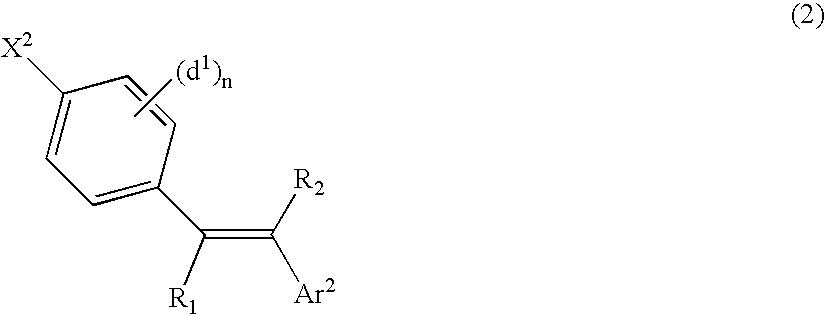Organic element for electroluminescent devices
- Summary
- Abstract
- Description
- Claims
- Application Information
AI Technical Summary
Benefits of technology
Problems solved by technology
Method used
Image
Examples
example 1
DEVICE EXAMPLE 1
EL Device Fabrication of Samples 1-5
[0183] An EL device (Sample 1) satisfying the requirements of the invention was constructed in the following manner: [0184] 1. A glass substrate coated with an 85 nm layer of indium-tin oxide (ITO) as the anode was sequentially ultrasonicated in a commercial detergent, rinsed in deionized water, degreased in toluene vapor and exposed to oxygen plasma for about 1 min. [0185] 2. Over the ITO was deposited a 1 nm fluorocarbon (CFx) hole-injecting layer (HIL) by plasma-assisted deposition of CHF3. [0186] 3. A hole-transporting layer (HTL) of N,N′-di-1-naphthyl-N,N′-diphenyl-4,4′-diaminobiphenyl (NPB) having a thickness of 75 nm was then evaporated from a tantalum boat. [0187] 4. A 20.0 nm light-emitting layer (LEL) of 2-t-butyl-9,10-di-(2-naphthyl)anthracene (tBADN) and including the boron complex light-emitting material, BD-7, at a level of 2% by volume of the LEL layer, and also including the stilbene compound, Inv-5, at a level of ...
example 2
DEVICE EXAMPLE 2
EL Device Fabrication of Comparative Samples 6-10
[0193] An EL device (Sample 6) was fabricated in the same manner as Sample 1, except the boron complex light-emitting material, BD-7, was replaced with light-emitting material ST-1 at a level of 2 volume %. Samples 7-9, incorporating Inv-5 and ST-1 were fabricated in an identical manner as Sample 6 except Inv-5 was used at the levels indicated in the Table 2. Sample 10 was constructed in the same manner as Sample 6 except Inv-5 was omitted.
[0194] Device Samples 6-10 were tested for efficiency and color at an operating current of 20 mA / cm2 and the results are reported in Table 2 in the form of CIE coordinates, efficiency (W / A), and the percent increase in efficiency relative to Sample 10 which did not contain Inv-5.
TABLE 1Testing Results For Samples 1-5.Inv-5EfficiencyIncrease inSampleTypeLevel (%)CIExCIEyW / AEfficiency1Inventive0.500.1500.2320.06013%2Inventive1.000.1490.2290.06319%3Inventive1.500.1480.2300.06523%4In...
PUM
| Property | Measurement | Unit |
|---|---|---|
| Percent by volume | aaaaa | aaaaa |
| Percent by volume | aaaaa | aaaaa |
| Time | aaaaa | aaaaa |
Abstract
Description
Claims
Application Information
 Login to View More
Login to View More - R&D
- Intellectual Property
- Life Sciences
- Materials
- Tech Scout
- Unparalleled Data Quality
- Higher Quality Content
- 60% Fewer Hallucinations
Browse by: Latest US Patents, China's latest patents, Technical Efficacy Thesaurus, Application Domain, Technology Topic, Popular Technical Reports.
© 2025 PatSnap. All rights reserved.Legal|Privacy policy|Modern Slavery Act Transparency Statement|Sitemap|About US| Contact US: help@patsnap.com



